6 Ways to Protect Plants from Frost
This post may contain affiliate links, which means that I may receive a commission if you make a purchase using these links. As an Amazon Associate I earn from qualifying purchases.
Most gardeners are eager to get something growing in their vegetable garden after the long winter. Unfortunately, Jack Frost may not be ready to release his icy grip completely and can send us a couple of unexpected frosts in late spring.
Tender garden plants can’t tolerate frost. So instead of losing them, protect plants from unexpected frosts with these methods.
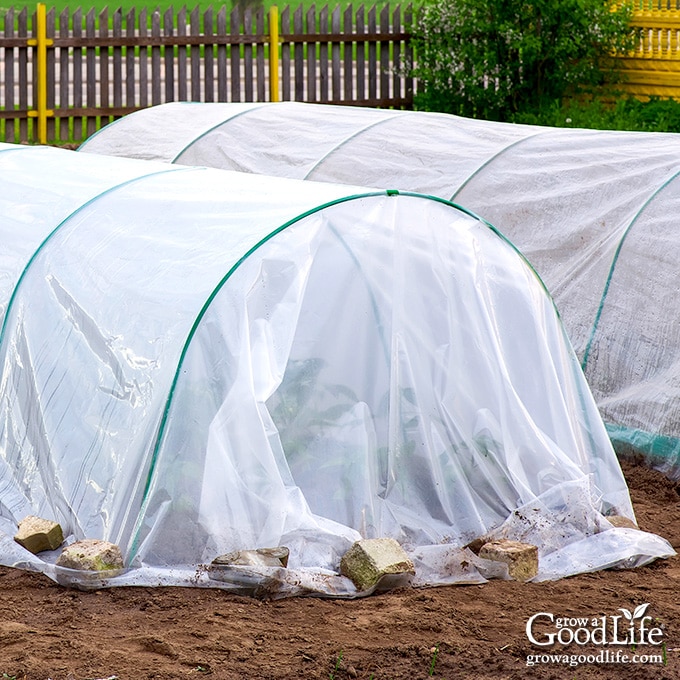
Memorial Day Weekend is the traditional time to get the garden planted for my area. It seems safe since our average last frost day is mid May. Spring weather too often teases us with sunny days and warmer nights enough to sway us to believe that winter is finally finished. Let the gardening season begin!
Even if you wait to plant your vegetable garden well beyond your average last frost date, sometimes Mother Nature can surprise you with a cold snap. I have learned through the years to keep an eye on the weather, and be ready to protect frost sensitive plants if nighttime temperatures dip near freezing.
Which Vegetables are Vulnerable to Frost
A frost occurs when the air temperature dips below 32˚F (0˚C) at ground level. A hard frost or freeze is a period of at least four consecutive hours of air temperatures that are below 28˚F (-2˚C).
Many plants can survive a brief frost, but very few can survive a hard freeze. Frost damage occurs when the liquid in the plants tissues freezes and bursts due to the cold temperatures.
Some plants have flexibility in their tissues and can withstand a certain amount internal ice formation without serious injury.
Plants likely damaged by light frost:
Vegetable garden crops that are most vulnerable to unexpected late spring frosts are young seedlings and the heat loving summer crops. Any plants that are specified on the seed package to be planted after all danger of frost is past are defenseless to an unexpected frost.
Frost tender plants include beans, corn, cucumbers, eggplants, melons, okra, peppers, squash, sweet potatoes, and tomatoes. These plants will be damaged or killed by frost if left unprotected.
Plants that can withstand light frost:
Semi-hardy vegetables can survive light frosts that dip to 32˚F. These include artichokes, bok choy, Chinese cabbage, cauliflower, celery, collards, leaf lettuce, mustard, peas, potatoes, and radishes.
Plants that can withstand hard frost:
Established cold hardy plants can tolerate lower temperatures as low as 20˚F. However, new transplants and young seedlings may be vulnerable. These vegetables include arugula, broccoli, Brussels sprouts, beets, cabbage, carrots, kale, kohlrabi, leeks, onions, parsnips, radishes, rutabaga, spinach, Swiss chard, and turnip.
6 Ways to Protect Plants from Unexpected Frost
Sudden cold snaps and shifting temperatures can take their toll on frost sensitive vegetables. Here are several methods to protect your plants from unexpected overnight frost:
Water the Plants During the Day
Water your garden soil thoroughly during the day before evening frost is predicted. Damp soil can hold four times more heat than dry soil. It will also conduct heat as the soil releases moisture and warm the air near ground level.
Watering your garden when temperatures are still above freezing will help hold in some thermal heat when the temperatures dip overnight.
Cover Plants with Old Blankets and Sheets
Old blankets and sheets are a great way to protect plants from frost. The blanket will help insulate tender plants and keep them alive during a frosty night.
Use stakes or hoops to hold the material up and away from the foliage and drape the blanket over the plants until it touches the ground. Secure the edges with boards, stones, or bricks to hold it in place to prevent cold air from seeping in.
Slip old pillowcases over the tomato cages creating an insulating air pocket around the plants. You can cover these with additional blankets for extra protection.
Cover in early evening just before the sun goes down. Remove the covers in the morning so the plants do not overheat.

Protect Your Garden with Hoops and Plastic
Use a grow tunnel mini-greenhouse to protect your plants from overnight frost. Or use 10-foot pieces of PVC to make hoops over a raised bed and drape with 5 mil painters plastic for some frost protection Secure the edges to keep heat in and cold out.
Wait to cover until the sun begins to set so your plants don’t overheat. Remove the plastic in the morning to allow your plants to breathe and warm up naturally.
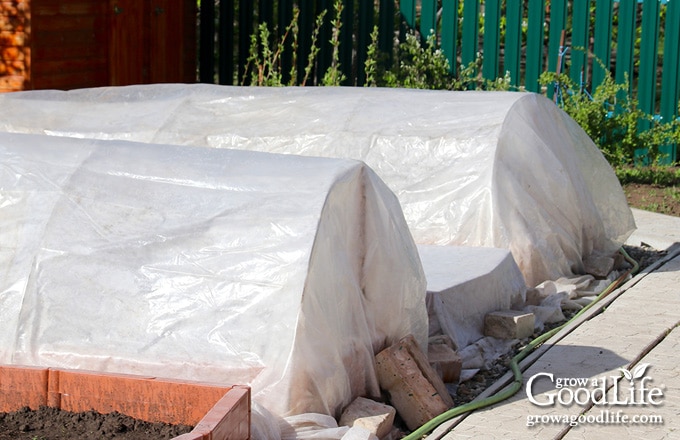
Place Containers Over Frost Tender Seedlings
Place buckets, pots, storage totes, garbage cans, cloches or any large container over frost tender seedlings. Weigh down with rocks or bricks if it is breezy.
The containers will create an insulating pocket around your plants. Cold air is prevented from seeping in and residual heat from soil is held near plants. Uncover in the morning once the temperature warms up above freezing.
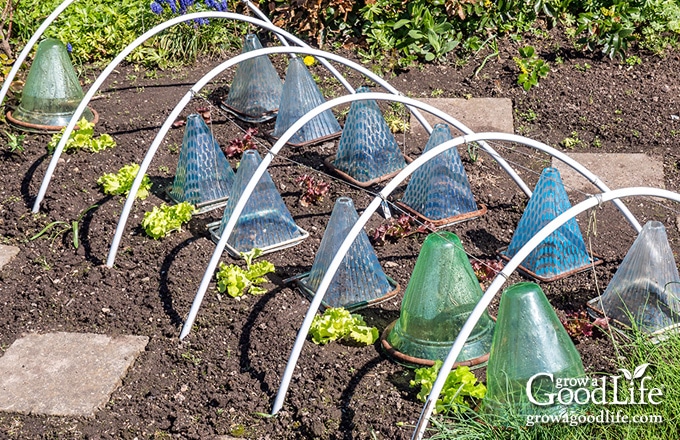
Use a Garden Frost Blanket or Row Cover
Frost blankets, floating row covers, and garden quilts are made from a lightweight woven material made specifically for protecting plants. The fabric allows some light to penetrate and is breathable, so it can be left on during the day if extended protection is needed.
Frost blankets come in varying thicknesses. Thicker quilts protect plants to a greater degree than thinner row covers. Thinner row covers can protect plants down to 28˚F, while thicker frost quilts protect plants down to 24˚F.
Like other coverings, frost blankets work by excluding cold air and creating an insulating air pocket around plants. Heat from soil, which is warmer than air, is trapped beneath the blanket and held near plants.
Use hoops or fencing to create an arch over your plants, drape the frost blankets, and anchor the edges to keep heat in and cold air out. You can remove the frost blanket once the threat of frost has passed. Or, since the fabric is breathable, you can leave it on for additional protection. Just be sure to check your plants to make sure they are not overheating.
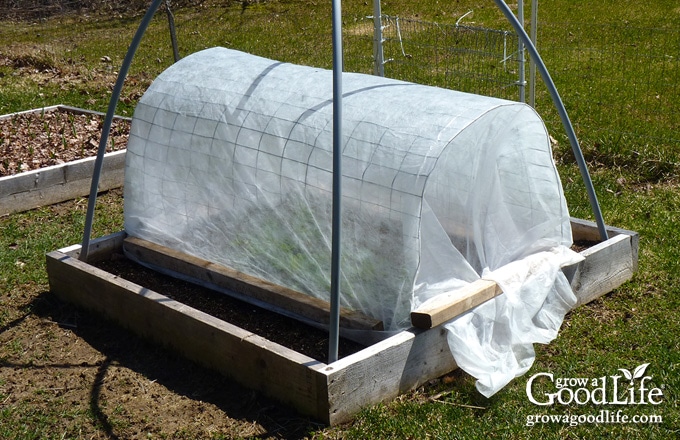
Add Heat
If the predicted overnight frost is unusually cold, extra heat may help keep your plants from freezing. In addition to covering frost tender plants, you can add heat beneath the cover.
Fill milk jugs and containers with hot water and place under the protective covering to serve as a source of extra heat around the plants.
Use a string of older, non-LED lights to help keep plants warmer. String the lights along the arch supports beneath the coverings. Keep the lights from touching your plants and fabric.
Tips for Covering Garden Plants for Frost Protection
When to Cover: When frost is predicted, water the plants during the day so the damp soil can absorb light energy from the sun. Overnight, that heat will gradually radiate out of the soil into the air. Cover the plants late in the afternoon just before the sun goes down to create a tent over the soil to contain a pocket of warmer air.
Cover Completely: The goal of covering the plants is to trap warm air under the canopy. Make sure your covering reaches the ground and use boards, stones, or bricks to hold it in place to keep warm air in and prevent cold air from seeping in.
Keep the Covering Away from the Pant: Make sure the cover doesn’t touch the plant. The material covering the plants can pass moisture and cold to the foliage if they are touching. Use stakes or hoops to keep the coverings from touching the plants.
Remove the Coverings in the Morning: Remove the covering in the morning and let the plants warm up naturally. Heat from the sun can build beneath solid coverings, and plants can die from high temperatures.
What to Do if You Discover Frost Damaged Plants
It is easy to be caught off guard by an unexpected frost. Once you wake up to frosty morning, what should be done?
If your tender plants are damaged by frost, they may have blackened foliage, wilted stems and leaves, or even the whole plant may have fallen over.
Allow the plants time to thaw and warm naturally. Sometimes, you will discover only a few leaves at the top of the plant were killed by frost. These will look shriveled and wilted by afternoon. Simply prune off the damaged foliage and your plant should recover.
Plants that have black foliage and stems are not likely to recover. Or if they do, they will be weak and won’t produce much of a harvest. Replace these plants with healthy ones.
—-
It can be a real disappointment to lose young garden plants if an unexpected late spring frost hits. I hope these tips will help you be ready to protect frost sensitive plants if nighttime temperatures dip near freezing.
Good planning is key to a successful vegetable garden
Whether you are new to growing your own food or have been growing a vegetable garden for years, you will benefit from some planning each year. You will find everything you need to organize and plan your vegetable garden in my PDF eBook, Grow a Good Life Guide to Planning Your Vegetable Garden.
You May Also Like
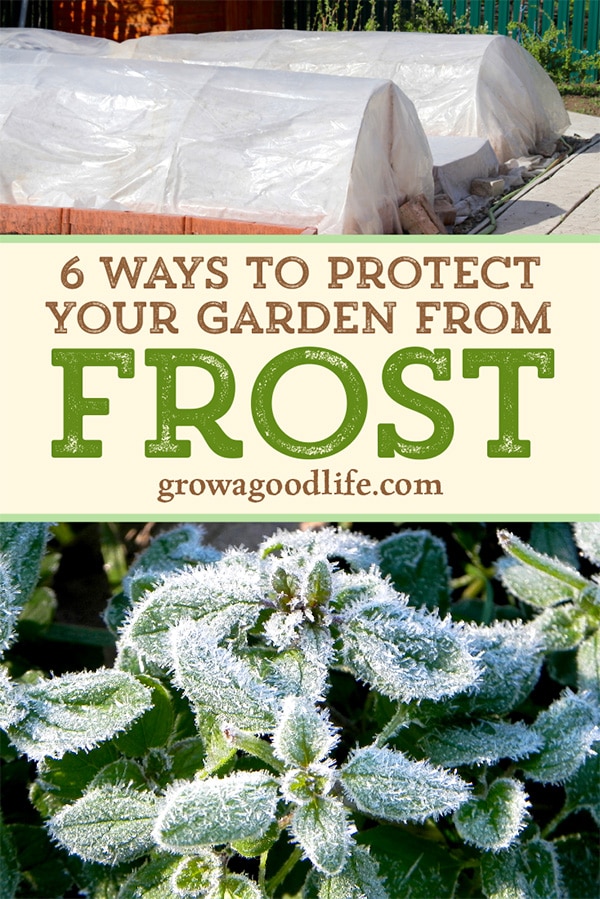


Where can I purchase the hoops that the frost guard cloth goes over? Do they come in lengths that can be cut e.g. loops over a ten foot high palm tree or large shrub.
Are there heaters suggested I can buy?
Terry, I use the flexible PVC pipes that can be arched into hoops. These come in sold in 10-foot lengths and most in 20-foot lengths. You can also find garden hoops, also known as row cover hoops, or frost protection frames, at garden centers, online gardening stores, or even larger hardware stores. These hoops often come in various sizes and materials, including flexible plastic or metal, that can be adjusted or cut to fit your specific needs, like draping over taller plants or shrubs. As for heaters, I’m not personally experienced with using them, but you may find them online as well.